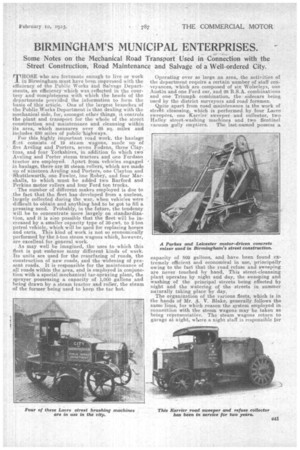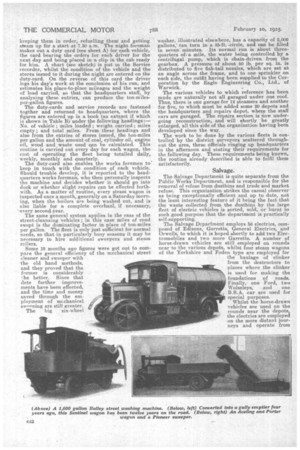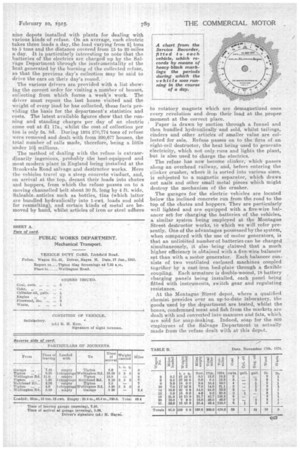BIRMINGHAM'S MUNICIPAL ENTERPRISES.
Page 25

Page 26

Page 27

If you've noticed an error in this article please click here to report it so we can fix it.
Some Notes on the Mechanical Road Transport Used in Connection with the Street Construction, Road Maintenance and Salvage of a Well-ordered City.
THOSE who are fortunate enough to live or work in Birmingham must have been impressed with the efficiency of the Public Works and Salvage Departments, an efficiency whichwas reflected in the courtesy and completeness with which the heads of the departments provided the information to form the basis of this article. One of the largest branches of the Public Works Department is that dealing with the mechanical side, far, amongst other things, it controls the plant and transport for the whole of the street construction and maintenance and cleansing within its area, which measures over 68 sq. miles and includes 630 miles of public highways.
For this highly important road work, the haulage fl:et consists of 19 steam wagons, made up of five Aveling and Porters, seven Fodens, three Claytons, and• four Yorkshires, in addition -Co which two Aveling and Porter steam tractors and one Fordson tractor are employed. Apart from vehicles engaged in haulage, there are 26 steam rollers, which are made up of nineteen Aveling and Porters, one Clayton and -Shattleworth, one Fowler, "one Robey, and four Marshalls, to which must be added two Barford and Perkins motor rollers and four Ford ton trucks.
The number of different makes employed is due to the fact that the fleet has developed from a nucleus, largely collected during the war, when vehicles were difficult to obtain and anything had to he got to fill a pressing need. Probably, in the future, the tendency will be to concentrate more largely on standardization, and it is also possible that the fleet will be increased by a smaller capacity type of 30-cwt. to 2-ton petrol vehicle, which will be used for replacing horses and carts. This kind of work is not so economically performed by the 5-ton steam wagons which, however, are excellent for general work.
As may well be imagined, the uses to which this fleet is put embrace many different kinds of work. Its units are used for the resurfacing of roads, the construction of new roads, and the .widening of present roads. It is responsible for the maintenance of all roads within the area, and is employed in conjunction with a special mechanical tar-spraying plant, the sprayer possessing a capacity of 1,000 gallons and being drawn by a steam tractor and roller, the steam of the former.being used to keep the tar hot.
Operating over so large an area, the activities of the department require a certain number of staff conveyances, which are composed of six Wolscleys, one Austin and one Ford ear, and 26 B.S.A. combinations and one Triumph combination, the sidecars being used by the district surveyors and road foremen.
Quite apart from road maintenance is the work of strett cleansing, which is performed by four Lacre sweepers, one .Karrier sweeper and collector, two Halley street-washing machmes and two Sentinel vacuum gully emptiers. The last-named possess a capacity of 800 gallons, and have been found extremely efficient and economical in use, principally owing to the fact that the road refuse and sweeping are never touched by hand, This street-cleansing plant operates by night and day, the sweeping and washing of the principal streets being effected by night and the watering of the streets in summer naturally taking place by day. The organization of the various fleets, which is in the hands of Mr. A. V. Blake, generally follows the same lines, for which reason the system employed in connection with the steam wagons may be taken as being representative. The steam wagons return to garage at night, where a night staff is responsible for keeping them in order, refuelling them and getting slYeam up for a start at 7.30 a.m. The night foreman makes out a duty card (see sheet A) for each vehicle, the card bearing the orders for each driver for the next day and being placed in a clip in the cab ready for him. A chart (see sketch) is put in the Service recorder, whilst the condition of the vehicle and the stores issued to it during the night are entered on the duty-card. On the reverse of this card the driver logs his day's work at the conclusion of his run, and estimates his place-to-place mileages and the weight of load carried, so that the headquarters staff, by analysing these entries, can produce the ton-milesper-gallon figures. The duty-cards and service records are fastened togther and returned to headquarters, where the figures are entered up in a book (an extract if which is shown in Table B) under the following headings:— No. of vehicle miles loaded ; weight carried ; miles empty ; and total miles. From these headings and also from the entries of stores issued, the ton-miles per gallon and the amount of coal, cylinder oil, engine oil, wood and waste used can be calculated. This routine is carried out every day for each wagon, the cost of operating the fleet being totalled daily, weekly, monthly and quarterly. The duty-card also enables the works foremen to keep in touch with the condition pf each vehicle. Should trouble develop, it is reported to the headquarters works foreman, who then personally inspects the machine and decides whether it should go into dock or whether slight repairs can be effected forthwith. As a matter of routine, every steam wagon is inspected once a month, generally on a Saturday morning, when the boilers are being washed out, and is also liable for a complete overhaul, if necessary, every second year. The same general system applies in the case of the street-cleansing vehicles ; in this case miles of road swept is the dominating factor in place of ton-miles per gallon. The fleet is only just sufficient for normal needs, so that in particularly busy seasons it may be necessary to hire additional sweepers and steam rollers.
Some 18 months ago figures were got out to compare the general efficiency of the mechanical street cleaner and sweeper with the old hand methods, and they proved that the former is considerably he better. Since that date further improve ments have been effected, and the time and money saved through the em ployment of mechanical sweening are still greater. The big six-wheel washer, illustrated elsewhere, has a capacity of 2,000 gallons; can turn in a 35-ft. circle, and can be filled in seven minutes. Its normal run is about threequarters of. a mile, the water being controlled by a centrifugal pump, which is chain-driven from the gearbox. A pressure of about 50 lb. per sq. in. is distributed, to five fish-tail nozzles, which are set at an angle across the frame, and to one sprinkler on each side, the outfit having been supplied to the Corporation by the Eagle Engineering Co., Ltd., of Warwick.
The various vehicles to which reference has been. made are naturally not all garaged under one roof. Thus, there is one garage for 12 steamers and another for five, to which must be added some 20 depots and the headquarters and repairs depot, where the staff cars are garaged. The repairs section is now undergoing reconstruction, and will shortly be greatly enlarged, all this side of the organization having been developed since the war.
The work to be done by the various fleets is controlled by the district surveyors scattered throughout the area, these officials ringing up headquarters in the afternoon and stating their requirements for the following day. These requirements being known, the routine already described is able to fulfil them satisfactorily.
Salvage.
The Salvage Department is quite separate from the Public Works Department, and is responsible for the removal of refuse from dustbins and trade and market refuse. This organization strikes the casual observer as being exceptionally efficient and up to date, not the least interesting feature of it being the fact that the waste collected from the dustbins by the large fleet of electric vehicles is sorted, sold, or burnt to such good purpose that the department is practically self-supporting.
The Salvage Department employs t6 electrics, composed of Edisons, Garretts, General Electrics, and Orwells, to which it is hoped shortly to add two Electromobiles and two more Garretts. A number of horse-drawn vehicles are still employed on rounds near to the various depots, whilst four steam wagons of the Yorkshire and Foden type are employed for the haulage of clinker from the destructors to places where the clinker is used for making the foundations of roads. Finally,one Ford, two Wolseleys, and one B.S.A. car are used for special purposes.
WINK,
Whilst the horse-drawn vehicles are used on the rounds near the depots, the electrics are employed on the more distant journeys and operate from
nine depots installed with plants for dealing with various kinds of refuse. On an average, each electric takes three loads a day, the load varying from 21 tons to 5 tons and the distance covered from 15 to 20 miles a day. It is particularly interesting to note that the batteries of the electrics are charged up by the Salage Department 'through the instrumentality of the heat generated by the burning of the collected refuse, so that the previous day's collection may be said to drive the ears on their day's round.
The various drivers arc provided with a list showing the correct order for visiting a number of houses, collecting from which forms a week's work. • The driver must report the last house visited and the weight of every load he has collected, these facts providing the basis for the department's statistics and costs. The latest available figures show that the running and standing charges per day of an electric conic out at 11 17s., whilst the cost of collection per ton is only 5s. Bd. During 1924 270,774 tons of refuse were removed and dealt with from 200,677 houses, the total number of calls made, therefore, being a little under 101 millions.
'The method of dealing with the refuse is extraordinarily ingenious, probably the best-equipped and most modern plant in England being installed at the Brookvale Road salvage and destructor works. Here the vehicles travel up a steep concrete viaduct, and, on arrival at the top, decant their loads into chutes and hoppers, from which the refuse passes on to a moving channelled belt about 20 ft. long by 4 ft. wide. Saleable -articles such as bottles, tins (which latter are bundled hydraulically into 1-cwt loads and sold for resmelting), and certain kinds of metal are hemoved by hand, whilst articles of iron or steel adhere to rotatory magnets which are every revolution and drop their moment at the correct place. demagnetized once load at the proper
Paper is drawn by suction through a funnel and then bundled hydraulically and sold, whilst tailings, cinders and other articles of smaller value are collected for sale. Reftise passes on to the -fires of an. eight-cell destructor, the heat being used to generate electricity, which not only runs and lights the plant, but is also used to charge the electrics.
The refuse has now become clinker, which passes along, an overhead railway, and, before entering the clinker crusher, where it is sorted into various sizes, is silbjeoted to a magnetic separator, which draws out nails and other small metal pieces which might destroy the mechanism of the crusher.
The garages for the electric vehicles are located below the inclined concrete run from the road to the top of the chutes and hoppers. They are particularly well lighted aod are equipped with a five-wire halanc,er set for charging the batteries of the vehicles, a similar system being employed at the Montague Street destructor works, to which we will refer presently. One of the advantages possessed by the system, when compared with the use of motor generators, is that an unlithited number of batteries can be charged simultaneously, it also being claimed that a much higher efficiency is obtained with a five-wire balancer set than with a motor generator. Each halancer cony slats of two ventilated enclosed machines coupled together by a east-iron bed-plate through a flexible coupling. Each armature is double-wound, 18 battery charging panels being installed, each panel being fitted with instruments, switch gear and regulating resistance.
At the Montague Street depot, where a qualified chernist presides over an up-to-date laboratory, the goods used by the department are tested, whilst the bones, condemned meat and fish from the markets are dealt with and converted into manures and fats, which are sold for soap-Making. Indeed, soap for the BOO employees of the Salvage Department is actually made from the refuse dealt with at this depot.














































